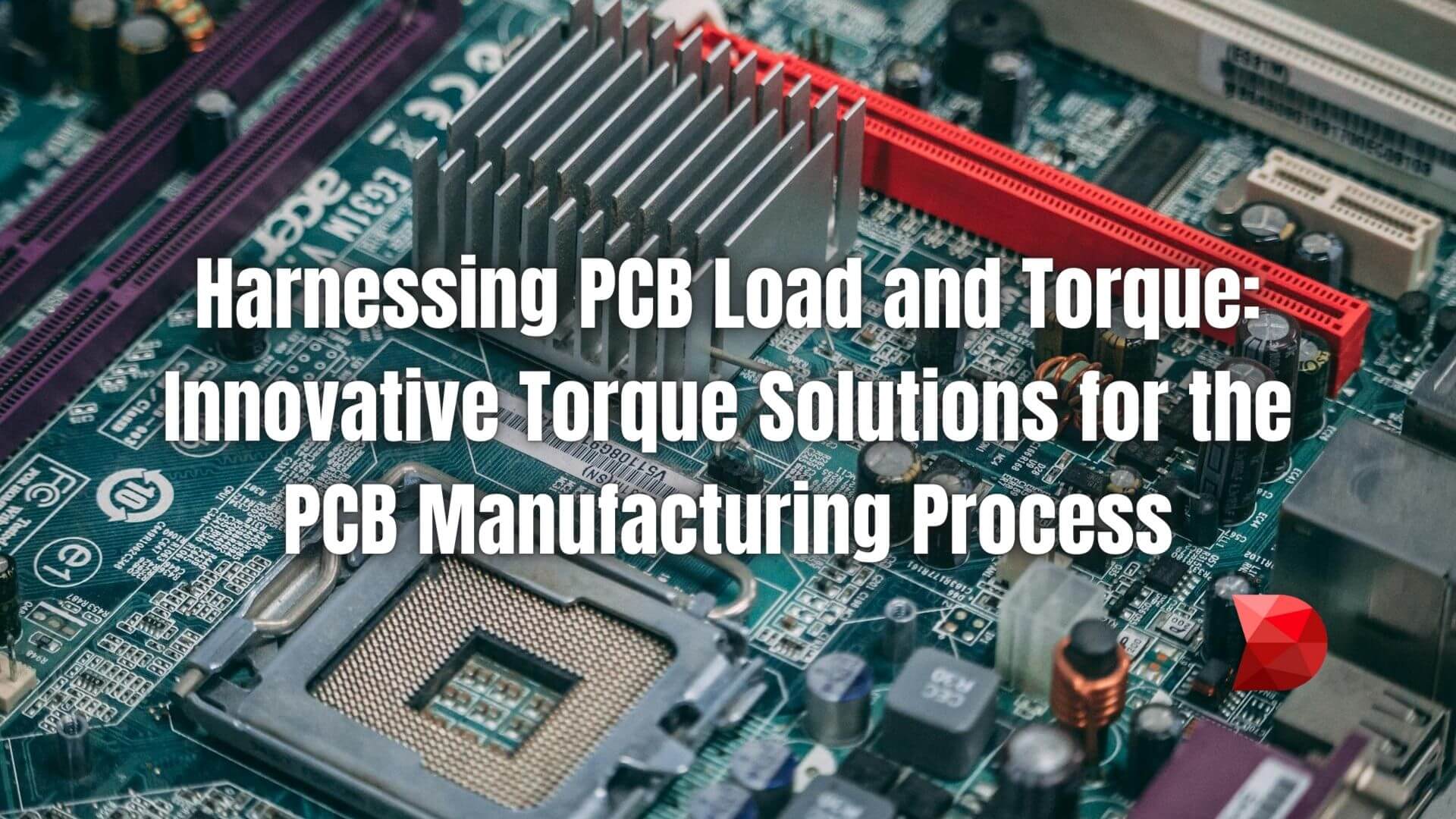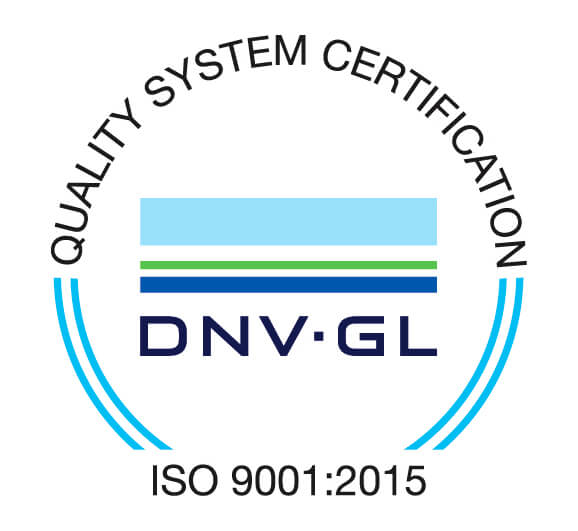Printed Circuit Boards (PCBs) are pivotal in modern electronic devices as they provide the framework for various small-scale components. However, the reliability and functionality of these devices depend not only on the design and quality of the PCB but also on the precise application of Torque during assembly.
In the context of PCB assembly, Torque is the rotational force used to hold fasteners like screws or bolts in place while securing components to the board. Proper torque application is critical to ensure the integrity of the assembly. It prevents issues such as loose connections, mechanical failures, and electrical malfunctions.
This article delves into the complex relationship between PCB load and Torque, why Torque is important during the assembly process, the repercussions of applying Torque incorrectly, and the best practices for getting the proper Torque during PCB assembly.
Table of Contents
ToggleUnderstanding PCB Load and Torque
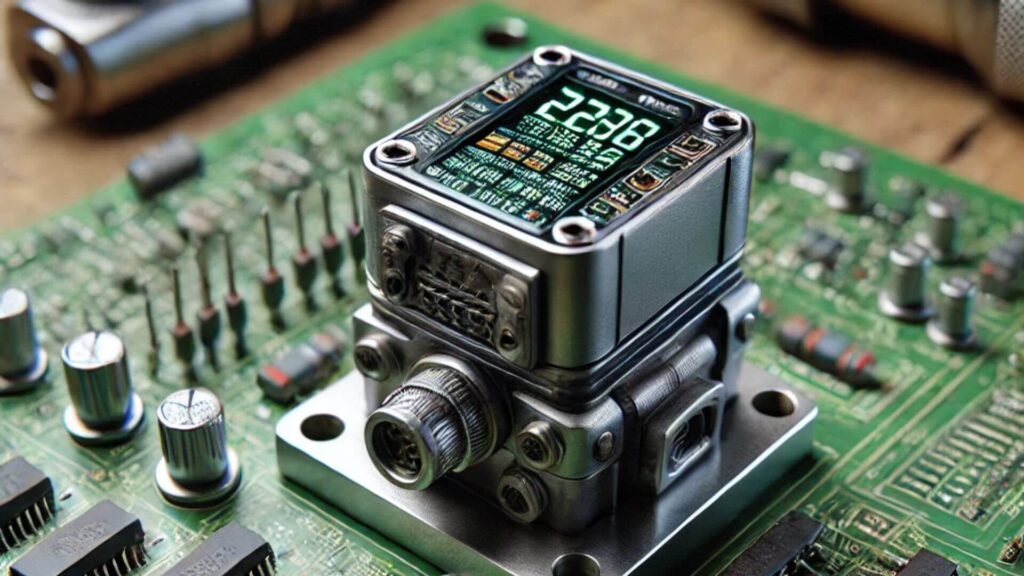
The printed circuit board (PCB) load and Torque during PCB assembly are critical elements that significantly impact electronic devices’ overall reliability and quality. Understanding these concepts and how they apply to the production process is essential.
- PCB Load: PCB load describes the force exerted on a printed circuit board (PCB) during assembling. This force is deliberately applied to guarantee proper contact and connection between electronic components such as integrated circuits, resistors, capacitors, and the PCB itself. The longevity and optimum functioning of the electronic item depend on the accuracy with which the load is applied.
- Torque in PCB Assembly: Torque, in the context of PCB assembly, is the rotational force applied during the tightening of screws or fasteners that secure components onto the board. It is a critical parameter as it determines the tightness of the connection, preventing issues such as loose connections, which can lead to electrical failures or malfunctions.
Key Factors Affecting Load and Torque in PCB Assembly
To assemble PCBs precisely, load and Torque must be carefully controlled. These two criteria largely determine the final PCB product’s lifespan, dependability, and quality. The following essential variables affect how load and Torque are applied throughout the assembling process:
- Component Type and Size: As the components vary from tiny resistors to larger integrated circuits, different torque values are also required when fastening them. Understanding the various demands of every component type and size is vital to prevent excessive or insufficient tightening.
- Material Variations: A careful approach is needed to prevent damage or deformation during assembly because PCBs and components are made of various materials, each with distinct mechanical qualities that affect the Torque necessary for secure joining.
- Threaded Fasteners and Screws: The selection of threaded screws and fasteners complicates the fastening process because Torque is affected by thread types, materials, and sizes. Understanding the suggested torque values is essential for maintaining stability and avoiding mechanical strain.
- Environmental Conditions: Torque standards must consider the completed electronic device’s operational environment, including temperature, humidity, and external forces.
- Assembly Equipment Calibration: Regular calibration of assembly equipment, including torque wrenches and fastening tools, is crucial for maintaining consistency and preventing deviations from recommended torque values.
The Role of Load and Torque in Ensuring Quality PCBs
Throughout the PCB building process, load and Torque are essential components that maintain quality requirements. Their influence are necessary in maintaining the longevity and general operation of electrical devices by:
- Component Security: Precision torque application ensures secure component fastening to PCB, preventing mechanical failures, ensuring stability, and preventing issues from loose or overly tightened components.
- Electrical Connectivity: Torque is essential for reliable electrical connections, preventing conductivity issues, intermittent connections, and malfunctions when tightened during connector and terminal tightening.
- Mechanical Stress Prevention: Precision torque control eliminates mechanical stress on PCBs, ensuring structural integrity by preventing over-tightening screws and fasteners.
- Consistent Quality Assurance: Standardizing Torque tightening procedures in PCB assembly ensures consistent quality, aligns with industry standards, and meets strict reliability and performance criteria.
Challenges in PCB Load and Torque Management
PCB torque and load must be effectively controlled to keep electronic equipment dependable and functional. Manufacturers, however, must deal with particular types of challenges related to this activity to maintain the integrity of the assembly process.
Common Issues and Problems in Managing Load and Torque
In PCB assembly, controlling load and Torque is a difficult process that, if not carried out precisely, can result in a number of problems affecting the performance and quality of electronic devices. The following typical issues can occur during the load and torque management process:
- Inconsistent Application: It can be difficult to ensure uniform application of load across the PCB, which can cause uneven tension on components. Differences in tightness caused by inconsistent torque delivery can jeopardize the stability of connections.
- Material Variability: Differences in the components’ and PCBs’ material composition can have an impact on how they react to Torque and applied load. Variations in the characteristics of the materials can trigger unequal tightening or compression, which lowers the assembly’s overall quality.
- Dynamic Environmental Conditions: Changes in humidity and temperature during assembly can affect how well load and torque applications work. Materials may expand or contract according to environmental conditions, which might eventually alter how stable connections are.
- Complex PCB Designs: Complex PCB designs with tightly spaced components make it difficult to verify that the load is distributed evenly. Tight spaces and sophisticated designs increase the complexity of torque management.
- Human Error in Assembly: Human error can occur during manual assembly operations when discrepancies in the applied force or torque parameters exist. Variations in the application of load and Torque may arise from the absence of regular operating procedures.
Consequences of Inadequate Load and Torque Control
Insufficient load and torque control in PCB assembly can lead to immediate manufacturing issues and long-term reliability concerns in electronic devices, which often include:
- Electrical Failures: Poor electrical contact from an inadequate load can result in irregular connections and, eventually, electrical malfunctions. Electrical failures could arise from slack connections caused by insufficient Torque.
- Mechanical Stress on Components: When a load is delivered incorrectly, components may experience uneven stress, leading to physical damage or premature malfunction.
- Signal Degradation: Signal deterioration and potential data loss may arise from inadequate load and torque control, jeopardizing signal integrity.
- Reduced Reliability and Lifespan: Poor load and torque control makes a device less reliable and has a shorter lifespan. Component failures become more frequent, lowering the electrical product’s overall quality.
Innovative Torque Solutions
Keeping up with cutting-edge torque solutions is essential to improving the accuracy and effectiveness of load and torque management in PCB production. This section explores cutting-edge tools and technologies intended to completely transform how we approach PCB assembly.
Emerging technologies and tools for load and torque management
Advancements in technology are revolutionizing PCB load and torque management in electronics manufacturing, enhancing precision, efficiency, and quality control throughout the assembly process. The following are some significant advances in PCB load and torque management technology and tools:
- Torque Sensing Devices: Assembly tools incorporate sophisticated torque sensors for immediate feedback on torque levels, ensuring torque values remain within defined limits during the tightening process
- Automated Torque Control Systems: Automated systems employ robotics and intelligent algorithms to consistently apply Torque across multiple fasteners, reducing manual labor and risks of human error.
- Smart Assembly Tools: Next-generation assembly tools feature features like Torque presets, data logging, and real-time monitoring, enhancing manufacturing efficiency by facilitating seamless integration with automation.
- Artificial Intelligence (AI) in Torque Management: AI algorithms analyze torque sensor data to adjust settings based on PCB and component characteristics, enabling continuous improvement through machine learning and historical torque data.
- Ultrasonic Torque Measurement: Ultrasonic technology is used for non-contact torque measurement, providing a precise and non-destructive method for applications where direct contact sensors may interfere with delicate components.
How Do These Solutions Address the Challenges in PCB Manufacturing?
The new technologies and tools for PCB load and torque management address a number of issues in PCB manufacturing. The following describes how these solutions specifically address the difficulties encountered throughout the PCB manufacturing process:
Smart Torque Wrenches
- Challenge Addressed: Inconsistent Torque Application
- Solution: With real-time feedback from smart torque wrenches, users can apply Torque consistently and accurately. The instantaneous feedback reduces torque level variations by enabling operators to adjust quickly.
Torque Control Software
- Challenge Addressed: Lack of Real-Time Monitoring and Control
- Solution: Torque control software allows real-time monitoring of torque values, ensuring they stay within specified ranges and can integrate with assembly line control systems for seamless control and parameter adjustment.
Automated Torque Verification Systems
- Challenge Addressed: Manual Inspection Challenges
- Solution: Automated systems utilize robotics and machine vision to swiftly inspect torque points, reducing the need for manual inspections and ensuring uniform torque application.
Ultrasonic Torque Measurement
- Challenge Addressed: Difficulty in Tightening Certain Fasteners
- Solution: The non-contact ultrasonic torque measuring procedure can be helpful when conventional methods are hard to apply. It can be used with a range of fasteners to measure Torque accurately.
Digital Twin Technology
- Challenge Addressed: Lack of Pre-Assembly Simulation
- Solution: Digital twin technology enables manufacturers to simulate torque scenarios before assembly, identifying potential issues and optimizing torque settings in a virtual environment.
Machine Learning and Artificial Intelligence (AI):
- Challenge Addressed: Difficulty in Optimizing Torque Settings
- Solution: AI algorithms use historical torque data to identify patterns and optimize torque settings for specific components or materials, while machine learning models continuously improve torque control processes based on real-world performance data.
Benefits of Effective Load and Torque Management
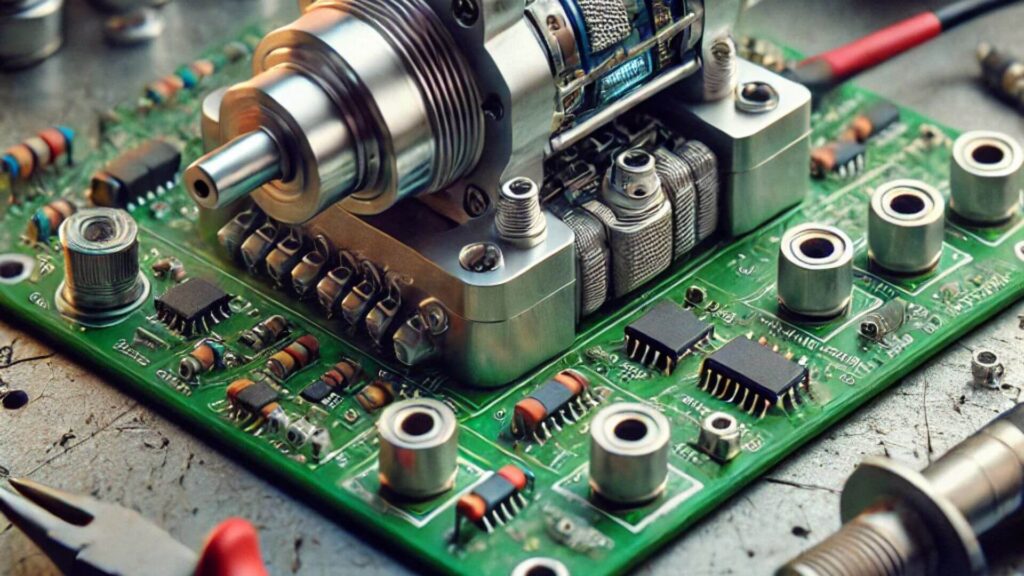
Apart from merely fulfilling technical specifications, ensuring proper PCB load and torque control during the PCB manufacturing process directly impacts the finished product’s overall quality, dependability, and productivity. These aspects work together to produce high-quality electronic goods that satisfy consumers and industry standards.
Improving Product Quality and Reliability
An important objective in PCB manufacturing is increasing product quality and reliability. This can be done using various techniques, with load and torque control being key components.
- Standardized Torque Procedures: Establish accurate torque settings for varying parts and materials; consistent torque methods throughout the PCB construction process ensure precision and prevent assembly errors.
- Operator Training and Certification: Implement comprehensive training programs for assembly operators, focusing on proper torque application techniques and ensuring their skills are validated through certification processes.
- Utilize Smart Torque Tools: Smart torque wrenches and tools equipped with sensors and real-time feedback enable operators to adjust Torque on the spot, ensuring accurate and consistent application.
- Automation and Robotics: Consider automation and robotics for torque-sensitive activities. Automated torque verification systems can guarantee consistency throughout the assembly line, improve torque application precision, and reduce dependence on manual checks. Inspections and ensure uniformity across the assembly line.
- Quality Control Inspections: Integrate comprehensive quality control examinations during pivotal phases of the assembly procedure. Employ technology like machine vision to examine torque application locations and detect any irregularities or flaws.
Enhancing Production Efficiency and Reducing Rework
Increasing production efficiency and decreasing rework necessitates a systematic approach considering several assembly process factors. The essential strategies to accomplish these objectives are as follows:
- Real-Time Monitoring and Feedback: Put real-time torque application monitoring and feedback systems in place. Use technology like smart torque tools, which give operators rapid input to enable quick adjustments while minimizing the need for rework over torque-related problems.
- Advanced Quality Control Inspections: Use modern innovations like machine vision to improve quality control checks. It is less likely that defective assemblies will make it to later stages of production and necessitate rework when automated inspections can promptly detect torque-related errors.
- Adequate Tool Maintenance and Calibration: Provide an established torque tool calibration and maintenance timetable. Accurate torque application is guaranteed by well-maintained tools, eliminating the likelihood of defective assemblies and the consequent requirement for rework.
- Digital Twin Simulation: Make use of digital twin technology to simulate and refine the torque application procedure prior to actual assembly. This reduces torque-related defects by enabling the diagnosis and elimination of potential flaws.
Cost Savings and Waste Reduction
The following strategies should be taken into account to reduce expenses and waste during the manufacturing process:
- Optimizing Material Use: Apply Torque properly to prevent over-tightening and the potential damage to components that come with it. Doing so minimizes material waste from defective or scrapped PCBs, lowering costs.
- Lean Inventory Management: Streamline inventory control procedures to cut down on surplus inventory and material waste. Precise torque management helps minimize the number of defective assemblies, reducing expenses on materials and component waste.
- Energy-Efficient Production: Adopt energy-efficient production techniques to help save money and maintain a sustainable environment.
- Waste Recycling. Implement waste recycling initiatives to reduce the impact of scrapped materials on the environment.
Implementing Load and Torque Solutions
Using load and torque solutions in PCB assembly requires a methodical strategy incorporating quality control, training, and technology. The objective is to optimize electronic systems’ mechanical stability and overall reliability. Below is a detailed operational guideline for effectively implementing PCB load and torque solutions
Steps to Incorporate Innovative Torque Solutions in PCB Manufacturing
A methodical and planned strategy is needed to integrate innovative torque solutions into PCB manufacturing. The following stages will help you through the process:
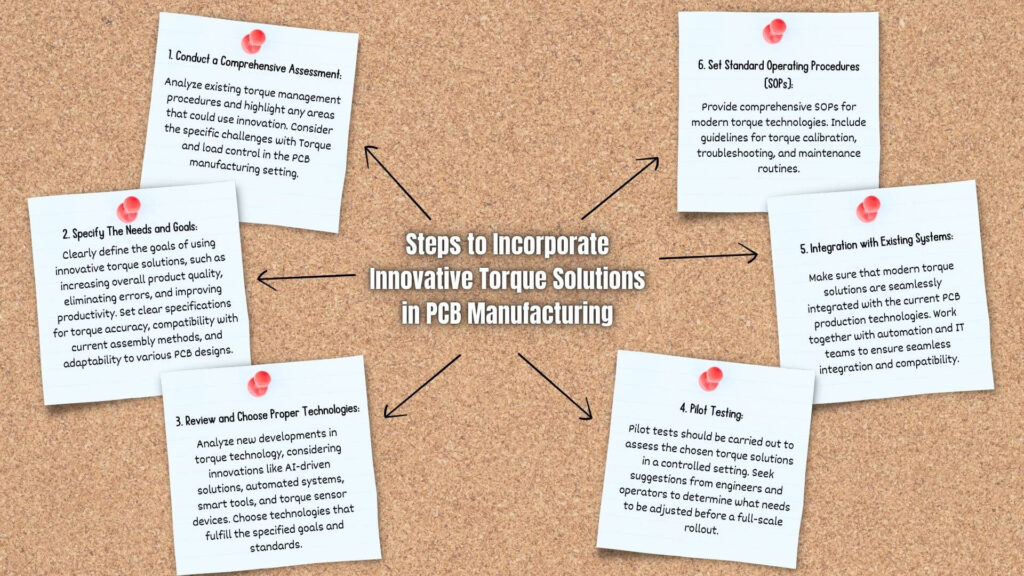
- Conduct a Comprehensive Assessment: Analyze existing torque management procedures and highlight any areas that could use innovation. Consider the specific challenges with Torque and load control in the PCB manufacturing setting.
- Specify The Needs and Goals: Clearly define the goals of using innovative torque solutions, such as increasing overall product quality, eliminating errors, and improving productivity. Set clear specifications for torque accuracy, compatibility with current assembly methods, and adaptability to various PCB designs.
- Review and Choose Proper Technologies: Analyze new developments in torque technology, considering innovations like AI-driven solutions, automated systems, smart tools, and torque sensor devices. Choose technologies that fulfill the specified goals and standards.
- Pilot Testing: Pilot tests should be carried out to assess the chosen torque solutions in a controlled setting. Seek suggestions from engineers and operators to determine what needs to be adjusted before a full-scale rollout.
- Integration with Existing Systems: Make sure that modern torque solutions are seamlessly integrated with the current PCB production technologies. Work together with automation and IT teams to ensure seamless integration and compatibility.
- Set Standard Operating Procedures (SOPs): Provide comprehensive SOPs for modern torque technologies. Include guidelines for torque calibration, troubleshooting, and maintenance routines.
Best Practices for Load and Torque Control
Adopting the best techniques for managing load and Torque is necessary for securing the dependability, excellence, and productivity of printed circuit board assembly. Consider the following essential recommended practices:
- Define Torque Specifications: Indicate the torque requirements for various parts and materials. Establish consistent torque values based on industry standards by working with component manufacturers.
- Operator Training and Certification: Provide operators with comprehensive training courses on proper torque application methods. Ensure that operators are certified and knowledgeable about torque control processes.
- Consider Smart Torque Tools: Use intelligent torque instruments with real-time monitoring features. These instruments give users immediate feedback, enabling accurate torque application and preventing mistakes.
- Maintenance and Calibration: Establish routine maintenance and calibration procedures for torque tools. Tools that are kept up to date assure torque application accuracy and help prevent inefficiencies resulting in faulty assembly.
- Torque Control Software: Adopt torque control software to track and manage torque values in real-time. This software should be able to analyze data obtained from torque tools to ensure that Torque remains within predefined limits.
Training and Skill Development for Operators and Engineers
It is vital to provide training and skill development for engineers and load and torque operators to maintain a skilled labor force that can carry out accurate and dependable assembly procedures. Here are some essential factors to consider:
- Torque Theory and Principles: Provide comprehensive instruction in torque theory, stressing the importance of applying Torque correctly to achieve mechanical stability. Include concepts like torque units, correlations between Torque and tension, and how Torque affects various fastener types.
- Tool Familiarization: Train engineers and operators on the range of torque tools available for PCB assembly. This covers automated torque drivers, handheld torque wrenches, and other specialized instruments. Ensure they know the particular uses and restrictions associated with every tool.
- Calibration Procedures: Emphasize the significance of tool calibration and educate operators on the correct calibration methods. Highlight the necessity of routine calibration to preserve torque application accuracy and support consistent and dependable outcomes.
- Troubleshooting: Train operators and engineers with troubleshooting abilities so they can quickly detect and resolve torque-related issues. This also means recognizing the signs of excessive or insufficient tightness and taking necessary measures.
- Component-specific Training: Customize instruction to cover the specifics of applying Torque to various components. Different torque considerations can be required for components with different sizes, materials, and purposes.
Future Trends in PCB Load and Torque Management
As technology continues to evolve, several emerging developments are expected to influence PCB load and torque management. These developments are anticipated to improve PCB manufacturing’s accuracy, effectiveness, and general dependability.
Upcoming Technologies and Innovations in the Field
The following emerging technologies are anticipated to have a significant impact on load and torque management in the future:
- Smart Bolting Technology: Integrating sensors and digital communication into bolts and fasteners enables real-time monitoring of torque levels during and post-assembly.
- Impact: Improved accuracy in torque application, reduced assembly errors, and enhanced traceability of torque values.
- Augmented Reality (AR) Guidance Systems: AR systems provide operators with real-time guidance when applying Torque. Operators get visual signals and instructions displayed on the actual assembly components.
- Impact: Improved accuracy, simplified learning curve, and decreased torque application errors.
- Advanced Torque Measurement Sensors: Highly sensitive Torque measuring sensors with increased precision and the capacity to determine Torque accurately under environmental conditions.
- Impact: Greater reliability in torque measurements leads to improved product quality as well as lesser inconsistency.
- Cloud-Based Torque Data Analytics: Employing cloud computing to analyze real-time torque data across several manufacturing locations. Centralized monitoring and analysis are made possible using cloud-based technologies.
- Impact: Advanced data analytics and accessibility, as well as the capability to apply global torque controls.
- Precision Robotics for Torque Application: These robots have sophisticated grippers and torque sensors that allow them to apply Torque with extreme precision and consistency.
- Impact: Greater torque application efficiency, consistency, and precision, particularly for elaborate assemblies.
The Role of Industry 4.0 and Automation in Load and Torque Control
Combining these technologies results in improved accuracy, efficiency, and flexibility to meet the changing needs of contemporary PCB manufacturing procedures. The following examines their functions in relation to Torque and load control:
Real-Time Monitoring and Control
- Industry 4.0: Industry 4.0 strongly emphasizes connection and immediate data sharing. This results in tracking torque levels during the assembly process in real time.
- Automation: Automated systems can consistently satisfy torque criteria by monitoring torque values while performing real-time adjustments.
Predictive Maintenance
- Industry 4.0: Data about torque tool performance and usage can be gathered via sensors and connectivity.
- Automation: By analyzing this data, automated systems can determine when torque tool maintenance is necessary, saving downtime and preventing torque-related problems.
Process Optimization with Data Analytics
- Industry 4.0: PCB manufacturers can review historical torque data, identify trends, and enhance torque control procedures by integrating data analytics technologies.
- Automation: Utilize data analytics that adjust torque settings depending on previous results.
Integration of Robotics
- Industry 4.0: Robots with torque sensors can carry out routine tasks involving the proper torque application.
- Automation: High-precision torque application is facilitated by automated robotic systems that also lessen inconsistencies associated with manual methods.
Digital Twin Technology
- Industry 4.0: With digital twin technology, the assembly process can be virtually recreated, making torque simulation and optimization easier.
- Automation: Predict and optimize torque values using digital twin simulations prior to actual assembly.
Frequently Asked Questions
Q1: What role do torque and load control play in PCB manufacturing?
The accurate application of force and Torque throughout the assembly process is ensured in PCB production by load and torque control. Preserving the structural integrity of components, preventing damage, and attaining a consistent product quality generally rely on this precision.
Q2: How is Torque measured in PCB assembly?
Torque wrenches, torque screwdrivers, and other specialized torque tools are commonly used in PCB construction to measure Torque. The Torque that is applied to fasteners using these instruments is calibrated to a particular degree, and the Torque is detected by means of integrated sensors.
Q3: What are the common problems in load and torque control?
Common load and torque control challenges often come in component composition variations, the requirement for exact torque application in small-scale assemblies, and the likelihood of manual errors. Other issues include adapting to changing technological advances and maintaining constant Torque throughout a production line.
Measure Torque with DATAMYTE
DATAMYTE, a recognized industry leader in providing robust data collection and low-code quality management solutions, offers a range of torque products designed to enhance accuracy and efficiency in various manufacturing environments.
LightStar™ Torque Wrench
This precise torque-measuring instrument is designed to eliminate false readings that are difficult to detect. The LightStar™ Torque Wrench series technology sensor ensures that the operator can pull at any point on the wrench and will receive an accurate measurement.
DataMyte Torque Solution
This solution provides real-time reporting and torque data collection to improve and monitor Torque continuously. It’s a comprehensive system for managing all aspects of torque control, from data collection to analysis and reporting.
New Generation of Digital Torque Wrenches
DATAMYTE has introduced a new generation of their LightStar™ Carbon Fiber Torque Wrench. These digital torque wrenches offer improved performance and accuracy, making them ideal for demanding industrial applications.
These products are part of DATAMYTE’s commitment to providing quality management solutions that enhance actionable results based on collected production data. They are designed to ensure consistent, reliable torque application, improving the quality and reliability of assembled products. Book a demo with us now to see how we can help you achieve your torque accuracy goals.
Conclusion
The proper control of PCB load and Torque is crucial in determining the dependability and efficiency of electronic devices. Carefully applying Torque during assembly promotes the longevity of PCBs, reduces problems like signal deterioration, and guarantees mechanical stability.
With the introduction of innovative torque solutions, PCB manufacturers are presented with a transformative opportunity to elevate their practices and redefine the landscape of electronic assembly. Adopting these state-of-the-art technologies is rationalized based on environmental sustainability, efficiency, and quality assurance.
In a time when the longevity and reliability of electronic devices are increasing, it makes sense to adopt modern torque solutions to fulfill and exceed these demands.

